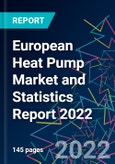The European Heat Pump Market and Statistics Report is the most comprehensive publication on the European Heat Pump market so far, including data from 21 European countries. The report has been structured to cover the different national statistics from EHPA national association members, with an overview of each market and its main development factors. This includes industrial and technical trends, the European as well as the national legislative frameworks, and the organizational status of each market.
European heat pump sales grew by +33.8% in 2021. With 2.17 million units sold across Europe, a new sales record has been achieved. Assuming a life expectancy of approx. 20 years, the current European heat pump stock amounts to 16.96 million units (see Table 1.0-1), of which 15.33 million are for space heating. With approximately 120 million residential buildings in Europe, the heat pump market share in the building stock is almost 14%.
Key contents
- Data from 21 countries
- EU policy trends
- Industry trends
- Energy trends
- Forecasts
Table of Contents
Editorial
1. Executive Summary
2. Policy
2.1. European Green Deal
2.2. Digitalisation
2.3. Product related policies
2.4. F-gas and refrigerants related policies
2.5. EU project Investment, Research, and Innovation
3. EU heat pump sales
3.1 European heat pump market development
3.2. Market segmentation
3.3. Heat Pump Benefits
3.4. Market Drivers
3.5. Heat pump market shares across Europe
4. Country Reports
4.1. Austria
4.2. Belgium
4.3. Czech Republic
4.4. Denmark
4.5. Estonia
4.6. Finland
4.7. France
4.8. Germany
4.9. Hungary
4.10. Ireland
4.11. Italy
4.12. Lithuania
4.13. Netherland
4.14. Norway
4.15. Poland
4.16. Portugal
4.17. Slovakia
4.18. Spain
4.19. Sweden
4.20. Switzerland
4.21. United Kingdom
5. Annex
5.1. EHPA sales data acquisition and processing methodology
5.2. Calculating the environmental benefits of the heat pump stock
6. Glossary
7. Revision history
List of Figures
List of Tables
Samples

LOADING...
Executive Summary
European heat pump sales grew by +33.8% in 2021. With 2.17 million units sold across Europe, a new sales record has been achieved. Assuming a life expectancy of approx. 20 years, the current European heat pump stock amounts to 16.96 million units, of which 15.33 million are for space heating. With approximately 120 million residential buildings in Europe, the heat pump market share in the building stock is almost 14%.
Heat pump market growth is mainly influenced by three trends:
1. From a technology perspective today's heat pumps can cover a wider temperature range. They still operate at -25°C and increasingly often they provide hot water at 65°C in an efficient manner. That enables their deployment in a much larger share of buildings than a decade ago. Hybrid systems enable heat pumps even in the renovation segment.
2. The need to accelerate the energy transition also in the heating and cooling sector moves heat pumps to the center of attention of policymakers. Legislation passed in the past 8 years is now transposed in all member states and it starts to show impact. Building standards limit maximum heat demand per m2, mandate the integration of renewable energy, and favour smart buildings. This is often substantiated by institutional and financial subsidies that make market development
easier.
3. Continuously larger and growing sales numbers result in lower costs. Economies of scale are materializing on the component and the product level. The fast decline of the production cost of PV systems also influences the heating market: using self-produced electricity in combination with a heat pump system provides a very low-cost energy source for buildings. Additional benefits like demand response services provided to the grid (which could become a business model and provide an income for their providers) are on the horizon but have not yet materialized.
These developments contribute to the development of Europe's heat pump markets.
Countries Covered
- Austria
- Belgium
- Czech Republic
- Denmark
- Estonia
- Finland
- France
- Germany
- Hungary
- Ireland
- Italy
- Lithuania
- Netherland
- Norway
- Poland
- Portugal
- Slovakia
- Spain
- Sweden
- Switzerland
- United Kingdom
Methodology

LOADING...








